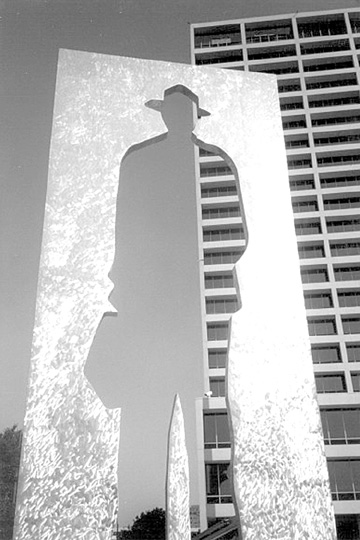 Fort Worth’s most notorious piece of public art: ‘Man With Briefcase.’
Fort Worth’s most notorious piece of public art: ‘Man With Briefcase.’
|
| Fort Worth Public Art public hearing\r\n\r\nWed, Sept 1, beginning at 5:30 p.m., at the Fort Worth Community Arts Center, 1300 Gendy Street. For more information or to suggest input, write to talkto@fwpublicart.org or Fort Worth Public Art, 1300 Gendy St, FW, 76107, or call 817-732-2360. |
|
A D V E R T I S E M E N T
|
|
|
|
A D V E R T I S E M E N T
|
|
Public Art and You
A few thoughts in preparation for Fort Worth Public Art’s public hearing, next week
By ANTHONY MARIANI
We’ve all seen him. Big, surrounded by metal, invisible. “Man With Briefcase” is both Fort Worth’s most infamous piece of public art and the best reason for non-art-loving Fort Worthians to engage the official public art community.
Fort Worth Public Art, the commission overseeing public art here, is taking input on the Draft Long Range Plan for the 2004 Capital Improvement Program, public art’s only source of local public funding. The commission is asking for folks to put in their two cents’ worth on the plan, via e-mail, snail-mail, or fax, for discussion in a public hearing on Wednesday, Sept. 1. Anybody who cares what the city looks and feels like should participate — including those of us who’d rather see philanthropists than bureaucrats playing the lead role in the development of public art.
Art ordered up by committees and public hearings is generally generic, mostly awful, totally populist. However, art allowed to blossom under the guiding light of a philanthropist usually turns out to be more original, more distinctive, more specific. Public money geared toward materials and equipment would be better spent on educating city officials, potential philanthropists, and potential public artists.
Art isn’t what it was back in the 1960s, when the National Endowment for the Arts, the chief vehicle through which we Americans could celebrate our sophistication and, more importantly, expose the unwashed to kulchur, was created. Public art is now nothing but a line item in a budget. The beginning of the downslide occurred not long after the NEA had become established, when regular joes and regular joe-ish public officials began acknowledging art’s pesky presence and soon became critics. Uneducated about art, these folks naturally began to question its pragmatic worth. Just telling them that art was good for the soul wasn’t enough. They wanted tangible results, and we art lovers played right into their hands by saying stuff like, “Look how much retail revenue was generated by this mural’s location next to two clothing stores.” After years of this, art began looking less like an enriching experience, more like a compendium of dollar signs as depicted by different artists. When compared to revenue generated by other public projects, art’s contribution is minimal, giving city personnel ammunition to cease funding altogether if necessary.
What we can do at City Hall is encourage the local government folk to throw their support behind individuals — not committees — who might not otherwise get involved in public art but who are financially capable of supporting it, even if this support amounts to a few cans of paint. Anyone who sits on a city council should realize that cities are made up of more than pothole-free roads and timely garbage pick-up. Cities — real cities — are repositories of the citizenry’s beliefs and values, phenomena made concrete largely through art.
And, for you supporters of committee-driven public art, keep this in mind before you fire off your input to FWPA: Anyone who tells you that a couple of fancy light posts or murals will help improve the quality of living here is trying to sell you something you shouldn’t buy. Yes, art is part of an equation that makes people want to move to or stay in a particular place. But by itself, it’s useless. A handsome mural on the side of a building won’t eliminate garbage or guns or bad schools.
This is where you come in. l
 Email this Article...
Email this Article...

